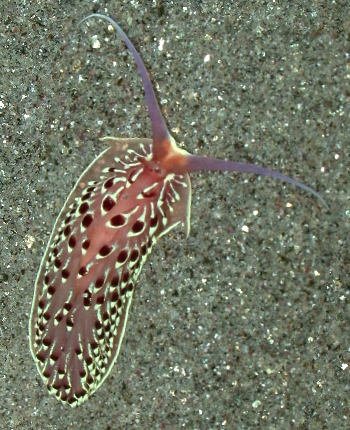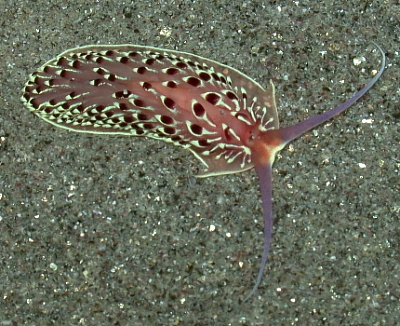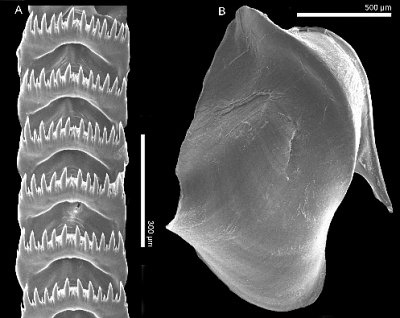
Cerberilla chavezi
Hermosillo & Valdes, 2007
Order: NUDIBRANCHIA
Suborder: AEOLIDINA
Family: Aeolidiidae
DISTRIBUTION
Known only from Bahia de Banderas and Manzanillo (Pacific coast of Mexico).
PHOTO
Locality: Manzanillo, 20 feet, Colima, Mexico, tropical eastern Pacific, 23 March 2004, Muddy bottom. Length: 18 mm. Photographer: Ali Hermosillo.
The body is typical of a species of Cerberilla, being relative wide, flattened and elongate, with the foot being about twice the width of the body. The anterior corners of the foot are extended into tentacular foot corners, and the oral tentacles are extremely long, almost two-thirds the body length. On the other hand the rhinophores, sitting close together in the midline, are very short. The cerata are arranged in angled rows. The ceratal shape varies in different parts of the body, the anterior ones being more swollen, flattened and club-shaped while the posterior ones are longer and more cylindrical.
The background color of the body is a translucent wine red, and appeaers darker in the centre of the body than at the edges, and on the foot. The edge of the foot is lined with a cream-yellow line. The oral tentacles are translucent purple with a pinkish base, and the rhinophores are translucent pinkish red with a cream tip. The cerata are translucent pinkish with an opaque cream yellow dorsal line running about halfway along each ceras where it is broken by a deep reddish brown patch just below the cream yellow tip.
Cerberilla chavezi grows to at least 19 mm long in length. It has been found crawling over or burrowing through sand.
-
Hermosillo A. & Valdés, A. 2007. Five new species of Aeolid nudibranchs (Mollusca, Opisthobranchia) from the Tropical Eastern Pacific. American Malacological Bulletin, 22: 119-137, 13 text figures, 1 color pl.
Rudman, W.B., 2007 (August 1) Cerberilla chavezi Hermosillo & Valdes, 2007. [In] Sea Slug Forum. Australian Museum, Sydney. Available from http://www.seaslugforum.net/find/cerbchav
Related messages
Cerberilla chavezi - new aeolid from the eastern Pacific
August 2, 2007
From: Alicia Hermosillo


Dear Bill,
Here is a bit about this newly described aeolid, Cerberilla chavezi, from the tropical eastern Pacific (TEP).
Cerberilla is a genus that is characterized by a wide body, short cerata, very long oral tentacles and small and simple rhinophores. The wide body helps them move around muddy soft bottoms and the small rhinos make it easier to burrow, usually during the day time or when disturbed by dive lights during the night. The radula has only one tooth [in each row], which is wide and denticulated.
Cerberilla chavezi is very colorful and disctinct. You can see that the very long purple oral tentacles are pulled back when burrowing.
Locality: Manzanillo, 20 feet, Colima, Mexico, tropical eastern Pacific, 23 March 2004, Muddy bottom. Length: 18 mm. Photographer: Ali Hermosillo.
So far, I have only found this species in Bahia de Banderas and Manzanillo (Pacific coast of Mexico). It will be very interesting to find out if other divers find it elsewhere. Look for muddy bottoms with scattered algae and hydroids... then go diving at night and be quick! It will burrow as soon as it feels the light. You will probably need a buddy to help you photograph it.
Cheers!
Ali
gueri25@hotmail.com
Hermosillo, A., 2007 (Aug 2) Cerberilla chavezi - new aeolid from the eastern Pacific. [Message in] Sea Slug Forum. Australian Museum, Sydney. Available from http://www.seaslugforum.net/find/20362
Thanks Ali,
-
Hermosillo A. & Valdés, A. 2007. Five new species of Aeolid nudibranchs (Mollusca, Opisthobranchia) from the Tropical Eastern Pacific. American Malacological Bulletin, 22: 119-137, 13 text figures, 1 color pl.
Best wishes,
Bill Rudman
